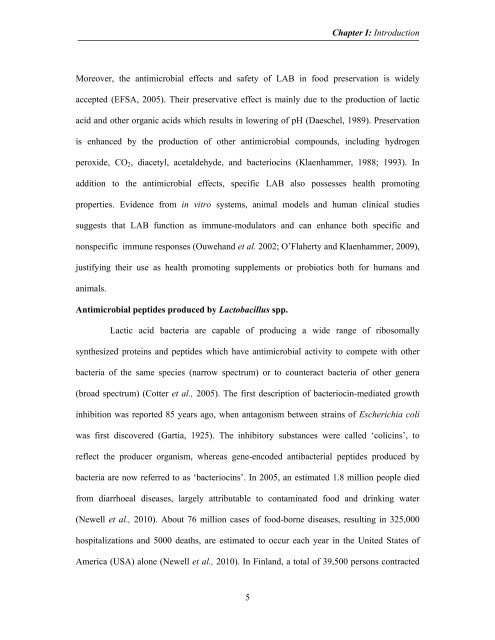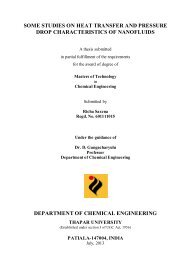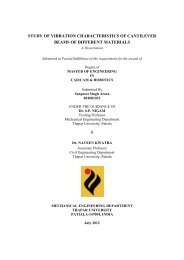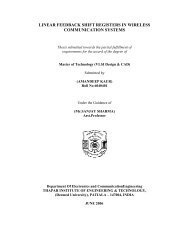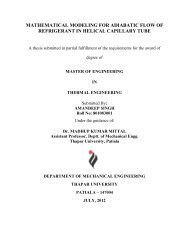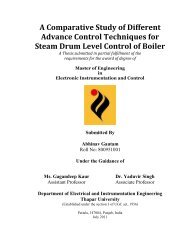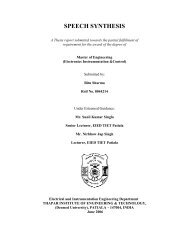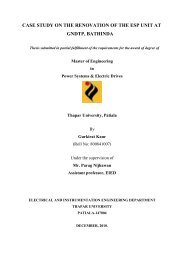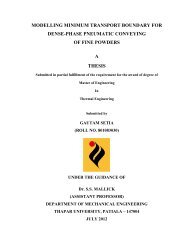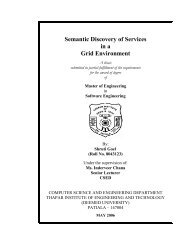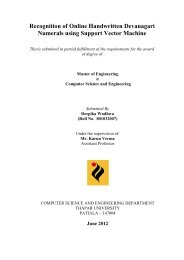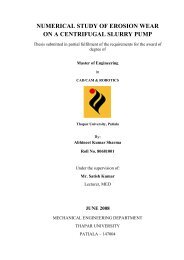from indigenous fermented foods and human gut ... - Thapar University
from indigenous fermented foods and human gut ... - Thapar University
from indigenous fermented foods and human gut ... - Thapar University
You also want an ePaper? Increase the reach of your titles
YUMPU automatically turns print PDFs into web optimized ePapers that Google loves.
5<br />
Chapter I: Introduction<br />
Moreover, the antimicrobial effects <strong>and</strong> safety of LAB in food preservation is widely<br />
accepted (EFSA, 2005). Their preservative effect is mainly due to the production of lactic<br />
acid <strong>and</strong> other organic acids which results in lowering of pH (Daeschel, 1989). Preservation<br />
is enhanced by the production of other antimicrobial compounds, including hydrogen<br />
peroxide, CO2, diacetyl, acetaldehyde, <strong>and</strong> bacteriocins (Klaenhammer, 1988; 1993). In<br />
addition to the antimicrobial effects, specific LAB also possesses health promoting<br />
properties. Evidence <strong>from</strong> in vitro systems, animal models <strong>and</strong> <strong>human</strong> clinical studies<br />
suggests that LAB function as immune-modulators <strong>and</strong> can enhance both specific <strong>and</strong><br />
nonspecific immune responses (Ouweh<strong>and</strong> et al. 2002; O’Flaherty <strong>and</strong> Klaenhammer, 2009),<br />
justifying their use as health promoting supplements or probiotics both for <strong>human</strong>s <strong>and</strong><br />
animals.<br />
Antimicrobial peptides produced by Lactobacillus spp.<br />
Lactic acid bacteria are capable of producing a wide range of ribosomally<br />
synthesized proteins <strong>and</strong> peptides which have antimicrobial activity to compete with other<br />
bacteria of the same species (narrow spectrum) or to counteract bacteria of other genera<br />
(broad spectrum) (Cotter et al., 2005). The first description of bacteriocin-mediated growth<br />
inhibition was reported 85 years ago, when antagonism between strains of Escherichia coli<br />
was first discovered (Gartia, 1925). The inhibitory substances were called ‘colicins’, to<br />
reflect the producer organism, whereas gene-encoded antibacterial peptides produced by<br />
bacteria are now referred to as ‘bacteriocins’. In 2005, an estimated 1.8 million people died<br />
<strong>from</strong> diarrhoeal diseases, largely attributable to contaminated food <strong>and</strong> drinking water<br />
(Newell et al., 2010). About 76 million cases of food-borne diseases, resulting in 325,000<br />
hospitalizations <strong>and</strong> 5000 deaths, are estimated to occur each year in the United States of<br />
America (USA) alone (Newell et al., 2010). In Finl<strong>and</strong>, a total of 39,500 persons contracted


